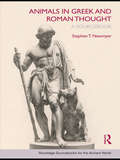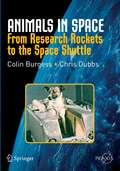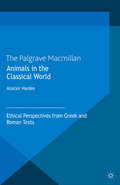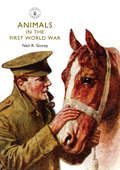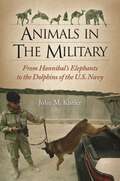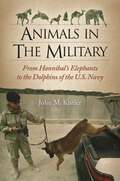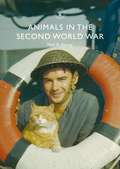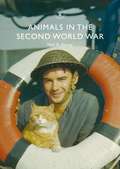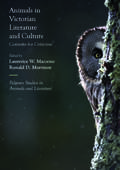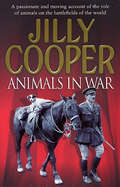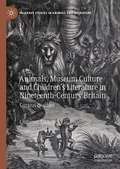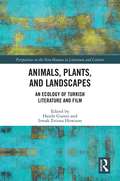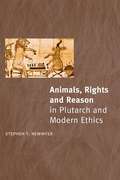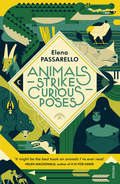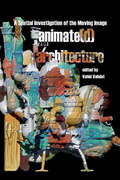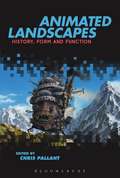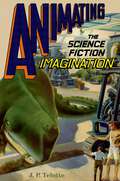- Table View
- List View
Animals in Greek and Roman Thought: A Sourcebook (Routledge Sourcebooks for the Ancient World)
by Stephen T. NewmyerAlthough reasoned discourse on human-animal relations is often considered a late twentieth-century phenomenon, ethical debate over animals and how humans should treat them can be traced back to the philosophers and literati of the classical world. From Stoic assertions that humans owe nothing to animals that are intellectually foreign to them, to Plutarch's impassioned arguments for animals as sentient and rational beings, it is clear that modern debate owes much to Greco-Roman thought. Animals in Greek and Roman Thought brings together new translations of classical passages which contributed to ancient debate on the nature of animals and their relationship to human beings. The selections chosen come primarily from philosophical and natural historical works, as well as religious, poetic and biographical works. The questions discussed include: Do animals differ from humans intellectually? Were animals created for the use of humankind? Should animals be used for food, sport, or sacrifice? Can animals be our friends? The selections are arranged thematically and, within themes, chronologically. A commentary precedes each excerpt, transliterations of Greek and Latin technical terms are provided, and each entry includes bibliographic suggestions for further reading.
Animals in Greek and Roman Thought: A Sourcebook (Routledge Sourcebooks for the Ancient World)
by Stephen T. NewmyerAlthough reasoned discourse on human-animal relations is often considered a late twentieth-century phenomenon, ethical debate over animals and how humans should treat them can be traced back to the philosophers and literati of the classical world. From Stoic assertions that humans owe nothing to animals that are intellectually foreign to them, to Plutarch's impassioned arguments for animals as sentient and rational beings, it is clear that modern debate owes much to Greco-Roman thought. Animals in Greek and Roman Thought brings together new translations of classical passages which contributed to ancient debate on the nature of animals and their relationship to human beings. The selections chosen come primarily from philosophical and natural historical works, as well as religious, poetic and biographical works. The questions discussed include: Do animals differ from humans intellectually? Were animals created for the use of humankind? Should animals be used for food, sport, or sacrifice? Can animals be our friends? The selections are arranged thematically and, within themes, chronologically. A commentary precedes each excerpt, transliterations of Greek and Latin technical terms are provided, and each entry includes bibliographic suggestions for further reading.
Animals in Space: From Research Rockets to the Space Shuttle (Springer Praxis Books)
by Colin Burgess Chris DubbsThis book is as a detailed, but highly readable and balanced account of the history of animal space flights carried out by all nations, but principally the United States and the Soviet Union. It explores the ways in which animal high-altitude and space flight research impacted on space flight biomedicine and technology, and how the results - both successful and disappointing - allowed human beings to then undertake that same hazardous journey with far greater understanding and confidence. This complete and authoritative book will undoubtedly become the ultimate authority on animal space flights.
Animals in the Classical World: Ethical Perspectives from Greek and Roman Texts (The Palgrave Macmillan Animal Ethics Series)
by A. HardenThis sourcebook presents nearly 200 specially-translated Greek and Roman texts from Homer to Plutarch, revealing the place of the animal in the moral consciousness of the Classical era. Philosophical, historical, dramatic and poetic texts explore how animals were regarded in all aspects of ancient life, from philosophy to farming.
Animals in the First World War (Shire Library #790)
by Neil R. StoreyThe burden of the Great War was not shouldered by soldiers alone: the tasks, the camaraderie, the day-to-day life and the devastation were all shared with the animals that accompanied the forces abroad. The horses that took part in the last cavalry charges or hauled heavy guns are the most famous examples, but were far from alone: pigeons carried vital messages, dogs sniffed out wounded soldiers, camels were used as beasts of burden in the desert, and even ships' cats and baby orang-utans had their parts to play. From noted historian Neil R. Storey, this book looks at all the practical ways in which animals were essential to the war effort, but is equally interested in their roles as companions, mascots and morale boosters – on land, in the air and at sea. Neil R. Storey is a social and military historian specialising in the impact of war on society. He has written over twenty-five books, countless articles and has given lectures across the UK, including at the Imperial War Museum. He has acted as a consultant on a number of television documentaries and dramas.
Animals in the Middle Ages: A Book Of Essays (Routledge Medieval Casebooks #Vol. 13)
by Nona C. FloresThese interdisciplinary essays focus on animals as symbols, ideas, or images in medieval art and literature.
Animals in the Middle Ages (Routledge Medieval Casebooks)
by Nora C. FloresThese interdisciplinary essays focus on animals as symbols, ideas, or images in medieval art and literature.
Animals in the Military: From Hannibal's Elephants to the Dolphins of the U.S. Navy
by John M. KistlerThis book pays tribute to the unrecognized warriors and unsung heroes of human warfare: millions of animals from a surprising variety of species, ranging from rodents to dolphins to llamas.When one thinks of war, armies of soldiers and assaults with bullets and bombs delivered by deadly machinery typically come to mind. Throughout human history, however, animals have also played significant roles in our armed conflicts. In Animals in the Military: From Hannibal's Elephants to the Dolphins of the U.S. Navy, author John M. Kistler examines these contributions, describing the work of animals in human warfare throughout time, from lowly insects to birds to elephants.Drawing on both ancient and modern sources, the book reveals the full scope of heroics and horror committed by—and against—animal warriors in three unique areas: animals in combat, animals in support, and animals in incidental and experimental roles. Each chapter describes a single species, chronologically recounting its fascinating place in human warfare over time, from insects used as stinging projectiles to message-delivering pigeons.
Animals in the Military: From Hannibal's Elephants to the Dolphins of the U.S. Navy
by John M. KistlerThis book pays tribute to the unrecognized warriors and unsung heroes of human warfare: millions of animals from a surprising variety of species, ranging from rodents to dolphins to llamas.When one thinks of war, armies of soldiers and assaults with bullets and bombs delivered by deadly machinery typically come to mind. Throughout human history, however, animals have also played significant roles in our armed conflicts. In Animals in the Military: From Hannibal's Elephants to the Dolphins of the U.S. Navy, author John M. Kistler examines these contributions, describing the work of animals in human warfare throughout time, from lowly insects to birds to elephants.Drawing on both ancient and modern sources, the book reveals the full scope of heroics and horror committed by—and against—animal warriors in three unique areas: animals in combat, animals in support, and animals in incidental and experimental roles. Each chapter describes a single species, chronologically recounting its fascinating place in human warfare over time, from insects used as stinging projectiles to message-delivering pigeons.
Animals in the Second World War (Shire Library #880)
by Neil R. StoreyThroughout the course of the Second World War, many millions of animals were enlisted to serve. Though they had no choice, yet they demonstrated loyalty, determination and bravery as they shared the burden of war with their human companions both on active service and on the Home Front. From the dogs trained to locate air-raid victims buried under rubble, to the mules that carried ammunition and supplies through the jungles of the Far East, each animal played a crucial role in the war effort. In fact, such was their contribution that those animals that showed exceptional gallantry or devotion to duty were recognised officially with the introduction of the Dickin Medal in 1943. This fascinating book draws from first-hand accounts and contemporary sources to reveal the wide-ranging contributions that animals made both on and off the battlefield.
Animals in the Second World War (Shire Library)
by Neil R. StoreyThroughout the course of the Second World War, many millions of animals were enlisted to serve. Though they had no choice, yet they demonstrated loyalty, determination and bravery as they shared the burden of war with their human companions both on active service and on the Home Front. From the dogs trained to locate air-raid victims buried under rubble, to the mules that carried ammunition and supplies through the jungles of the Far East, each animal played a crucial role in the war effort. In fact, such was their contribution that those animals that showed exceptional gallantry or devotion to duty were recognised officially with the introduction of the Dickin Medal in 1943. This fascinating book draws from first-hand accounts and contemporary sources to reveal the wide-ranging contributions that animals made both on and off the battlefield.
Animals in Victorian Literature and Culture: Contexts for Criticism (Palgrave Studies in Animals and Literature)
by Laurence W. Mazzeno Ronald D. MorrisonThis collection includes twelve provocative essays from a diverse group of international scholars, who utilize a range of interdisciplinary approaches to analyze “real” and “representational” animals that stand out as culturally significant to Victorian literature and culture. Essays focus on a wide range of canonical and non-canonical Victorian writers, including Charles Dickens, Anthony Trollope, Anna Sewell, Emily Bronte, James Thomson, Christina Rossetti, and Richard Marsh, and they focus on a diverse array of forms: fiction, poetry, journalism, and letters. These essays consider a wide range of cultural attitudes and literary treatments of animals in the Victorian Age, including the development of the animal protection movement, the importation of animals from the expanding Empire, the acclimatization of British animals in other countries, and the problems associated with increasing pet ownership. The collection also includes an Introduction co-written by the editors and Suggestions for Further Study, and will prove of interest to scholars and students across the multiple disciplines which comprise Animal Studies.
Animals In War: Valiant Horses, Courageous Dogs, And Other Unsung Animal Heroes (Lyons Press Series)
by Jilly Cooper ObePigeons carrying vital messages to and from the beleaguered city during the Siege of Paris; horses and mules struggling through miles of fetid mud to bring ammunition to the front in the Great War; dogs sniffing out mines for the British invasion force in the Second World War - countless brave animals have played their part in the long, cruel history of war. Some have won medals for gallantry - like G.I. Joe, the American pigeon who saved 100 British lives in Italy, and Rob, the black and white mongrel who made over twenty parachute jumps with the SAS. Too many others have died abandoned, in agony and alone, after serving their country with distinction. Jilly Cooper has here written a tribute to the role of animals in wartime. It is a tragic and horrifying story - yet it has its lighter moments too: a hilarious game of musical chairs played on camels during the Desert Campaign; and the budgie who remarked, when carried from a bombed-out East End tenement, 'This is my night out'. This is a vivid and unforgettable record of man's inhumanity to animals, but also an astonishing story of courage, intelligence, devotion and resilience.
Animals, Museum Culture and Children’s Literature in Nineteenth-Century Britain: Curious Beasties (Palgrave Studies in Animals and Literature)
by Laurence TalairachAnimals, Museum Culture and Children’s Literature in Nineteenth-Century Britain: Curious Beasties explores the relationship between the zoological and palaeontological specimens brought back from around the world in the long nineteenth century—be they alive, stuffed or fossilised—and the development of children’s literature at this time. Children’s literature emerged as dizzying numbers of new species flooded into Britain with scientific expeditions, from giraffes and hippopotami to kangaroos, wombats, platypuses or sloths. As the book argues, late Georgian, Victorian and Edwardian children’s writers took part in the urge for mass education and presented the world and its curious creatures to children, often borrowing from their museum culture and its objects to map out that world. This original exploration illuminates how children’s literature dealt with the new ordering of the world, offering a unique viewpoint on the construction of science in the long nineteenth century.
Animals, Plants, and Landscapes: An Ecology of Turkish Literature and Film (Perspectives on the Non-Human in Literature and Culture)
by Hande Gurses Irmak Ertuna HowisonThe landscape of Turkey, with its trees and animals inspires narratives of survival, struggle and escape. Animals, Plants, and Landscapes: An Ecology of Turkish Literature and Film, will be the first major study to offer fresh theoretical insight into this landscape, by offering a collection of analyses of key texts of Turkish literature and cinema. Through discussion of both classical and contemporary works, this volume, paves the way for the formation of a ecocritical canon in Turkish literature and the rise of certain themes that are unique to Turkish experience. Snakes, fishermen and fish who catch men, porcupines contemplating on human agency, dogs exiled on an island and men who put dogs to fights, goat herders and windy steppes of Anatolia are all agents in a territory that constantly shifts. The essays included in this volume demonstrate the ways in which the crystallized relations between human and non-human form, break, and transform.
Animals, Plants, and Landscapes: An Ecology of Turkish Literature and Film (Perspectives on the Non-Human in Literature and Culture)
by Hande Gurses Irmak Ertuna HowisonThe landscape of Turkey, with its trees and animals inspires narratives of survival, struggle and escape. Animals, Plants, and Landscapes: An Ecology of Turkish Literature and Film, will be the first major study to offer fresh theoretical insight into this landscape, by offering a collection of analyses of key texts of Turkish literature and cinema. Through discussion of both classical and contemporary works, this volume, paves the way for the formation of a ecocritical canon in Turkish literature and the rise of certain themes that are unique to Turkish experience. Snakes, fishermen and fish who catch men, porcupines contemplating on human agency, dogs exiled on an island and men who put dogs to fights, goat herders and windy steppes of Anatolia are all agents in a territory that constantly shifts. The essays included in this volume demonstrate the ways in which the crystallized relations between human and non-human form, break, and transform.
Animals, Rights and Reason in Plutarch and Modern Ethics
by Stephen T. NewmyerThis groundbreaking volume explores Plutarch's unique survival in the argument that animals are rational and sentient, and that we, as humans, must take notice of their interests. Exploring Plutarch's three animal-related treatises, as well as passages from his ethical treatises, Stephen Newmyer examines arguments that, strikingly, foreshadow those found in the works of such prominent animal rights philosophers as Peter Singer and Tom Regan. Unique in viewing Plutarch’s opinions not only in the context of ancient philosophical and ethical through, but also in its place in the history of animal rights speculation, Animals Rights and Reasons points out how remarkably Plutarch differs from such anti-animal thinkers as the Stoics. Classicists, philosophers, animal-welfare students and interested readers will all find this book an invaluable and informative addition to their reading.
Animals, Rights and Reason in Plutarch and Modern Ethics
by Stephen T. NewmyerThis groundbreaking volume explores Plutarch's unique survival in the argument that animals are rational and sentient, and that we, as humans, must take notice of their interests. Exploring Plutarch's three animal-related treatises, as well as passages from his ethical treatises, Stephen Newmyer examines arguments that, strikingly, foreshadow those found in the works of such prominent animal rights philosophers as Peter Singer and Tom Regan. Unique in viewing Plutarch’s opinions not only in the context of ancient philosophical and ethical through, but also in its place in the history of animal rights speculation, Animals Rights and Reasons points out how remarkably Plutarch differs from such anti-animal thinkers as the Stoics. Classicists, philosophers, animal-welfare students and interested readers will all find this book an invaluable and informative addition to their reading.
Animals Strike Curious Poses
by Elena PassarelloBeginning with Yuka, a 39,000-year-old mummified woolly mammoth recently found in the Siberian permafrost, each of the sixteen essays in Animals Strike Curious Poses investigates a different famous animal named and immortalised by humans. Here are the starling that inspired Mozart with its song, Darwin’s tortoise Harriet, and in an extraordinary essay, Jumbo the elephant (and how they tried to electrocute him). Modelled loosely on a medieval bestiary, these witty , playful, provocative essays traverse history, myth, science and more, introducing a stunning new writer to British readers.
Animate(d) Architecture: A Spatial Investigation of the Moving Image
by Vahid VahdatAt their peak, architectural marvels such as the Sagrada Família, the Tower of London, the Mosque–Cathedral of Córdoba, and the Eiffel tower, had a combined annual visit of almost 16.4 million people. The animated icebound castle in Disney’s (2019) Frozen had 116.4 million views, from one single YouTube trailer, in less than 24 hours. The spaces of such massively consumed animation have for generations informed the architectural imagination of people across the globe and from very early in their lives. Yet, not only have the architectural disciplines remained rather absent in the design of these massively consumed spaces, architectural theory has likewise failed to articulate a framework to approach the architecture of animation. To address this void, this book offers an interdisciplinary approach to survey the role of space in animation, including in creating humorous moments in early cartoon shorts, generating action and suspense in Japanese anime, and even stimulating erotic pleasure in pornographic Hentai. Exploring the imagined architecture of animation, from early motion picture to digital animation and from computer graphics to game engines, offers an analytical frame to reconceptualize space.
Animate(d) Architecture: A Spatial Investigation of the Moving Image
At their peak, architectural marvels such as the Sagrada Família, the Tower of London, the Mosque–Cathedral of Córdoba, and the Eiffel tower, had a combined annual visit of almost 16.4 million people. The animated icebound castle in Disney’s (2019) Frozen had 116.4 million views, from one single YouTube trailer, in less than 24 hours. The spaces of such massively consumed animation have for generations informed the architectural imagination of people across the globe and from very early in their lives. Yet, not only have the architectural disciplines remained rather absent in the design of these massively consumed spaces, architectural theory has likewise failed to articulate a framework to approach the architecture of animation. To address this void, this book offers an interdisciplinary approach to survey the role of space in animation, including in creating humorous moments in early cartoon shorts, generating action and suspense in Japanese anime, and even stimulating erotic pleasure in pornographic Hentai. Exploring the imagined architecture of animation, from early motion picture to digital animation and from computer graphics to game engines, offers an analytical frame to reconceptualize space.
Animated Landscapes: History, Form and Function
by Chris PallantWinner of the 2017 McLaren-Lambart Award for Best Book on the Subject of AnimationStudying landscape in cinema isn't quite new; it'd be hard to imagine Woody Allen without New York, or the French New Wave without Paris. But the focus on live-action cinema leaves a significant gap in studying animated films. With the almost total pervasiveness of animation today, this collection provides the reader with a greater sense of how the animated landscapes of the present relate to those of the past. Including essays from international perspectives, Animated Landscapes introduces an idea that has seemed, literally, to be in the background of animation studies.The collection provides a timely counterpoint to the dominance of character (be that either animated characters such as Mickey Mouse or real world personalities such as Walt Disney) that exists within animation scholarship (and film studies more generally). Chapters address a wide range of topics including history, case studies in national contexts (including Australia, Japan, China and Latvia), the traversal of animated landscape, the animation of fantastical landscapes, and the animation of interactive landscapes. Animated Landscapes promises to be an invaluable addition to the existing literature, for the most overlooked aspect of animation.
Animated Landscapes: History, Form and Function
by Chris PallantWinner of the 2017 McLaren-Lambart Award for Best Book on the Subject of AnimationStudying landscape in cinema isn't quite new; it'd be hard to imagine Woody Allen without New York, or the French New Wave without Paris. But the focus on live-action cinema leaves a significant gap in studying animated films. With the almost total pervasiveness of animation today, this collection provides the reader with a greater sense of how the animated landscapes of the present relate to those of the past. Including essays from international perspectives, Animated Landscapes introduces an idea that has seemed, literally, to be in the background of animation studies.The collection provides a timely counterpoint to the dominance of character (be that either animated characters such as Mickey Mouse or real world personalities such as Walt Disney) that exists within animation scholarship (and film studies more generally). Chapters address a wide range of topics including history, case studies in national contexts (including Australia, Japan, China and Latvia), the traversal of animated landscape, the animation of fantastical landscapes, and the animation of interactive landscapes. Animated Landscapes promises to be an invaluable addition to the existing literature, for the most overlooked aspect of animation.
Animating Maria: A Novel Of Regency England - Being The Fifth Volume Of The School For Manners (School for Manners #5)
by M.C. Beaton'If you have a Wild, Unruly, or Undisciplined Daugher, two Ladies of Genteel Birth offer to Bring Out said Daughter and Refine what may have seemed Unrefinable. We can make the Best of the Worst'When Amy and Effie Tribble, two charming but impoverished spinster sisters, lose out on an inheritance, they place this advertisement in The Morning Post and hire themselves out as professional chaperones. Vowing to prepare even the most difficult misses for marriage, the Tribble sisters will spend a London season on each client, educating them in their School for Manners.Maria Kendall is seemingly a dream client - beautiful, impeccably mannered, effortlessly graceful and extremely well dowered. In short, she doesn't seem to need the Tribbles' help at all. But then the sisters meet her parents and realise that they do have a problem on their hands - not with the perfect Maria, but with her overweening, gauche and socially over-ambitious parents!
ANIMATING THE SCIENCE FICTION FILM C
by J.P. TelotteLong before flying saucers, robot monsters, and alien menaces invaded our movie screens in the 1950s, there was already a significant but overlooked body of cinematic science fiction. Through analyses of early twentieth-century animations, comic strips, and advertising, Animating the Science Fiction Imagination unearths a significant body of cartoon science fiction from the pre-World War II era that appeared at approximately the same time the genre was itself struggling to find an identity, an audience, and even a name. In this book, author J.P. Telotte argues that these films helped sediment the genre's attitudes and motifs into a popular culture that found many of those ideas unsettling, even threatening. By binding those ideas into funny and entertaining narratives, these cartoons also made them both familiar and non-threatening, clearing a space for visions of the future, of other worlds, and of change that could be readily embraced in the post-war period.
